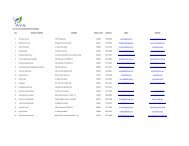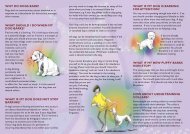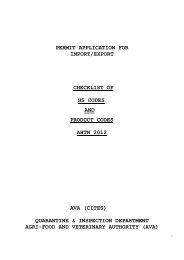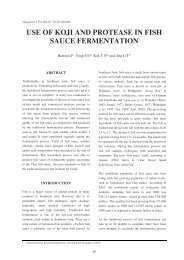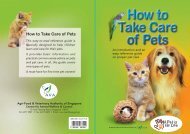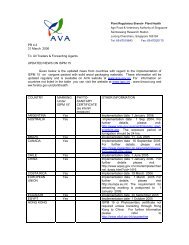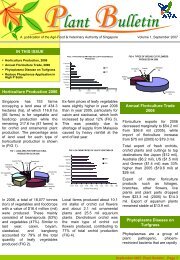2002/03 Annual report - Agri-Food & Veterinary Authority of Singapore
2002/03 Annual report - Agri-Food & Veterinary Authority of Singapore
2002/03 Annual report - Agri-Food & Veterinary Authority of Singapore
You also want an ePaper? Increase the reach of your titles
YUMPU automatically turns print PDFs into web optimized ePapers that Google loves.
AVA Service Centres<br />
AVA Service Centres act as the hub for all activities in support<br />
<strong>of</strong> AVA's effort towards food, animal and plant health.<br />
Aquaculture Services Centre<br />
Formerly known as the Freshwater<br />
Fisheries Centre, the Aquaculture Services<br />
Centre (ASC), plays an active role in<br />
facilitating the development <strong>of</strong> foodfish<br />
and ornamental fish trade and industry<br />
in <strong>Singapore</strong>. The name change reflects<br />
the expansion <strong>of</strong> services provided by<br />
the centre. ASC provides technical<br />
advice and support to investors, farmers<br />
and exporters involved in the foodfish<br />
aquaculture and ornamental fish business,<br />
promotes and encourages the industry to<br />
use science and modern technology for<br />
the production <strong>of</strong> high quality foodfish for<br />
local consumption and in the production<br />
and export <strong>of</strong> quality ornamental fish. In<br />
FY 02/<strong>03</strong>, ASC provided consultancy<br />
services to local and overseas parties<br />
and agencies on foodfish aquaculture<br />
and ornamental fish projects. It provides<br />
advisory services to dragon fish breeding<br />
farms and monitors the performance <strong>of</strong><br />
captive breeding and trading activities in<br />
these CITES-approved farms.<br />
Central <strong>Veterinary</strong> Laboratory<br />
The Central <strong>Veterinary</strong> Laboratory (CVL)<br />
is the national animal health laboratory<br />
and provides diagnostic services for the<br />
detection and identification <strong>of</strong> diseases in<br />
animals, birds and aquatic animals. It also<br />
<strong>of</strong>fers quality control testing services for<br />
veterinary vaccines. In addition to playing<br />
a supportive role to AVA’s disease<br />
surveillance programmes, CVL also serves<br />
farms, veterinary clinics, private and<br />
government organisations, and members<br />
<strong>of</strong> the public. The number <strong>of</strong> laboratory<br />
tests performed reached an all time high<br />
<strong>of</strong> 167,273 tests in FY 02/<strong>03</strong>, an increase<br />
<strong>of</strong> 2.1% over the previous year.<br />
Centre for Animal Welfare and Control<br />
The Centre for Animal Welfare and Control<br />
(CAWC) located at Pasir Panjang is a onestop<br />
centre for matters pertaining to<br />
animal welfare and control.<br />
CAWC’s main responsibility is the licensing<br />
and control <strong>of</strong> dogs in <strong>Singapore</strong>. It<br />
conducts daily inspections at residential<br />
areas and strives for a high level <strong>of</strong><br />
promptness in response to requests for<br />
investigation. In FY02/<strong>03</strong>, it managed to<br />
meet 96.5% <strong>of</strong> all requests within two<br />
working days. CAWC also loans animal<br />
traps to residents and organisations that<br />
have problems with stray cats or dogs.<br />
CAWC ensures the welfare <strong>of</strong> animals<br />
by investigating instances <strong>of</strong> animal<br />
cruelty and by licensing pet shops<br />
and exhibitions <strong>of</strong> animals. Routine<br />
inspections are also carried out on pet<br />
shops to check that illegal and exotic<br />
animals are not being sold.<br />
CAWC also promotes animal welfare and<br />
responsible pet ownership through public<br />
education, advisories and counselling.<br />
On average, some 100 talks are given<br />
each year to schools and the public. The<br />
Centre works closely with animal welfare<br />
groups and participates in exhibitions and<br />
roadshows to promote responsible pet<br />
ownership.<br />
Changi Animal & Plant Quarantine<br />
Station<br />
The Changi Animal & Plant Quarantine<br />
Station, sited within the Changi Airfreight<br />
Centre, conducts inspection <strong>of</strong> animals<br />
and birds, veterinary biologics and meat<br />
products, imported into <strong>Singapore</strong> by air.<br />
All imported products are checked and<br />
their health documentation verified to<br />
ensure that they are fit and free <strong>of</strong><br />
contaminants.<br />
Horticulture Services Centre<br />
The Horticulture Services Centre plays a<br />
key supporting role in the horticulture<br />
industry. It provides services in the areas<br />
<strong>of</strong> tissue culture, seed pod germination,<br />
consultancy, field evaluation and training,<br />
among others. The seed pod culture<br />
service continues to be popular amongst<br />
growers, hobbyists and schools as it<br />
allows the breeding and selection <strong>of</strong><br />
unique hybrids. A total <strong>of</strong> 182 seed pods<br />
were received, <strong>of</strong> which 6% were from<br />
Paphiopedilum (slipper orchid) hybrids.<br />
The laboratory protocol to successfully<br />
culture Paphiopedilum hybrids has been<br />
developed through an R&D project. In<br />
<strong>2002</strong>, the Centre also cloned a total <strong>of</strong><br />
21,000 plantlets <strong>of</strong> orchids and other<br />
exotic ornamental plants like pelargoniums,<br />
pitcher plants and Venus fly traps.<br />
Jurong Animal Quarantine Station<br />
The Jurong Animal Quarantine Station<br />
provides quarantine for imported animals<br />
such as horses, cattle, sheep, goats, dogs<br />
and cats. The station’s role is to ensure<br />
that no exotic animal diseases <strong>of</strong> public<br />
health or economic significance are<br />
introduced into <strong>Singapore</strong>. In FY 02/<strong>03</strong>,<br />
a total <strong>of</strong> 8,204 animals were quarantined<br />
at the station.<br />
Jurong and Senoko Fishing Ports<br />
The Jurong Fishing Port (JFP) is a port<br />
<strong>of</strong> call for foreign fishing vessels for the<br />
landing, wholesale and distribution <strong>of</strong><br />
fresh fish. A total <strong>of</strong> 106 AVA-licensed fish<br />
merchants currently operate in JFP. In FY<br />
02/<strong>03</strong>, JFP handled 74,834 tonnes <strong>of</strong> fish.<br />
Of these, 7,136 tonnes were tuna<br />
transhipments. During the same period,<br />
a total <strong>of</strong> 5,271 vessel calls were made at<br />
JFP. The five main fish supplying countries<br />
are Indonesia, Malaysia, Thailand, India<br />
and People’s Republic <strong>of</strong> China.<br />
Senoko Fishing Port (SFP) serves as a<br />
home base for the local fishing fleet.<br />
There are 25 AVA-licensed fish merchants<br />
currently operating here. SFP handles<br />
both local and imported fish. Local<br />
production comprises fish landed by local<br />
fishing trawlers, fish from kelongs and fish<br />
farms. In FY 02/<strong>03</strong>, 15,104 tonnes <strong>of</strong> fish<br />
were handled at SFP. A total <strong>of</strong> 465 vessel<br />
calls were made by local fishing trawlers<br />
at the port last year.<br />
Marine Aquaculture Centre<br />
The Marine Aquaculture Centre (MAC),<br />
located on St John’s Island was built at<br />
a cost <strong>of</strong> $33 million to undertake tropical<br />
marine foodfish aquaculture technology<br />
development. Its major programmes are<br />
in large-scale hatchery and fish farming,<br />
with state-<strong>of</strong>-the-art R&D facilities that are<br />
the first <strong>of</strong> its kind in the region. Special<br />
facilities include spawning tank systems,<br />
live food micro-organism culture systems,<br />
large-scale hatchery, and sea water re-use<br />
systems. The facilities were tested and<br />
commissioned over the year and most<br />
were in operation by the end <strong>of</strong> <strong>2002</strong>.<br />
The Centre commenced hatchery<br />
operations on a test scale concurrently<br />
while the systems were being commissioned.<br />
During this period, the Centre was<br />
successful in laying down the protocol for<br />
batch and mass production <strong>of</strong> live food<br />
micro-organisms which are required in fish<br />
larval rearing.<br />
The Intellectual Property Rights<br />
Identification and Protection Programme<br />
on Marine Hatchery Technology at St<br />
John’s Island, which began in 2001,<br />
was completed in <strong>2002</strong>. Areas <strong>of</strong> focus<br />
included IPR audit investigation and <strong>report</strong>,<br />
formulation <strong>of</strong> policies, and the drafting<br />
<strong>of</strong> employment-related and commercial<br />
agreements. Recommendations made in<br />
the course <strong>of</strong> the programme have since<br />
been adopted at MAC.<br />
Marine Fisheries Research<br />
Department/Southeast Asian Fisheries<br />
Development Centre<br />
As a member <strong>of</strong> the Southeast Asian<br />
Fisheries Development Centre (SEAFDEC),<br />
<strong>Singapore</strong> manages the Marine Fisheries<br />
Research Department (MFRD) through<br />
AVA.<br />
In FY 02/<strong>03</strong>, MFRD continued to play<br />
an active role in aiding the transfer <strong>of</strong><br />
technology to the fish processing industry<br />
and government sector. Nine research<br />
projects, a training course and one<br />
workshop were conducted both locally<br />
and regionally, training a total <strong>of</strong> 35 people<br />
from across the region.<br />
In July <strong>2002</strong>, MFRD’s chemistry laboratory<br />
received ISO/IEC 17025 accreditation<br />
for five tests in the field <strong>of</strong> Chemical &<br />
Biological Testing under the <strong>Singapore</strong><br />
Accreditation Council – <strong>Singapore</strong><br />
Laboratory Accreditation Scheme (SAC-<br />
SINGLAS).<br />
Plant Health Centre<br />
The Plant Health Centre is a resource<br />
centre providing analytical and diagnostic<br />
services for the identification <strong>of</strong> insect<br />
pests, diseases and nutrition problems<br />
<strong>of</strong> plants in <strong>Singapore</strong>. Its services include<br />
soil and growth media nutrient analysis,<br />
providing advice, training and consultation<br />
on the control <strong>of</strong> pests and disease<br />
management. In FY02/<strong>03</strong>, the Centre<br />
published a Pest Management Guide,<br />
a quarterly Plant Bulletin and released<br />
fortnightly pest alerts to farms, plant<br />
nurseries and National Parks Board.<br />
In addition to alerts on endemic or<br />
new pests, the Centre also provides<br />
information on diseases and disease<br />
control measures to agri-businesses<br />
and the public.<br />
The Centre also conducts plant health<br />
training courses on pest and disease<br />
management for orchid and aquatic plant<br />
cultivators, as well as students taking<br />
the Diploma Horticulture & Landscape<br />
Management Course at Ngee Ann<br />
Polytechnic. In FY 02/<strong>03</strong>, the Plant Health<br />
Laboratories performed 14,476 tests<br />
to diagnose plant pests and disease<br />
problems. It also hosted two plant<br />
clinics at the Garden Tech <strong>2002</strong> and the<br />
<strong>Singapore</strong> Flower Festival, providing plant<br />
health advisory and information services to<br />
some 50,000 visitors at the events.<br />
<strong>Veterinary</strong> Public Health Laboratory<br />
The <strong>Veterinary</strong> Public Health Laboratory<br />
(VPHL), is the regulatory food analytical<br />
laboratory <strong>of</strong> AVA. VPHL <strong>of</strong>fers a<br />
comprehensive range <strong>of</strong> analytical services<br />
covering a wide spectrum <strong>of</strong> chemical and<br />
microbiological hazards. Its capabilities<br />
include tests for disease causing, food<br />
poisoning and spoilage organisms,<br />
harmful chemicals, toxins and economic<br />
fraudulence. VPHL is also the national<br />
reference laboratory for pesticide residues.<br />
VPHL’s competent and pr<strong>of</strong>essional<br />
staff adopts internationally recognised<br />
procedures and standards, as well as<br />
state-<strong>of</strong>-the-art technology, to provide<br />
a multi-disciplinary laboratory service to<br />
the public and private sectors. It develops<br />
test capabilities to keep pace with the<br />
challenges <strong>of</strong>, and to maintain vigilance<br />
against, newly emerging chemical and<br />
microbiological hazards that may be<br />
present in food.<br />
In July <strong>2002</strong>, construction work began to<br />
relocate VPHL into an upgraded facility for<br />
optimal laboratory and food inspections.<br />
The $31.6 million project is anticipated to<br />
be completed in June 20<strong>03</strong>.<br />
Our service centres such as<br />
the Marine Aquaculture Centre<br />
are optimally equipped and<br />
competently staffed to support<br />
our functions.<br />
Page 62 Page 63



